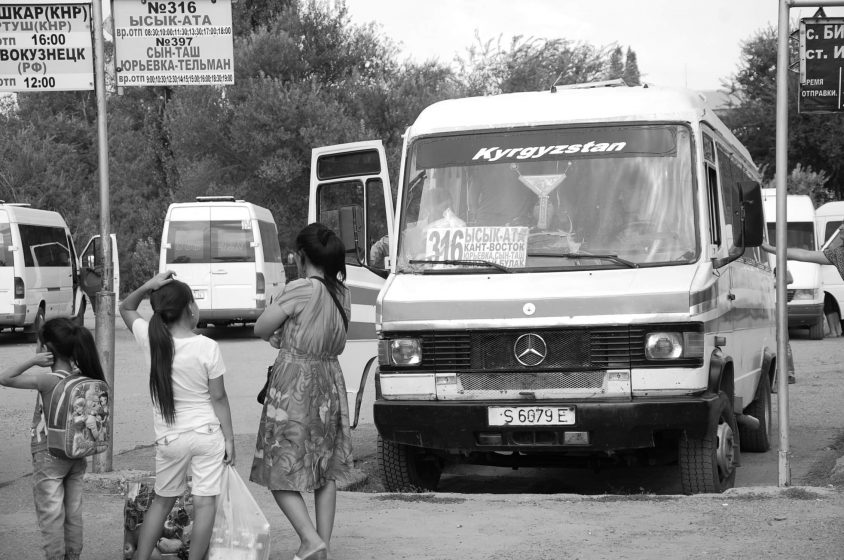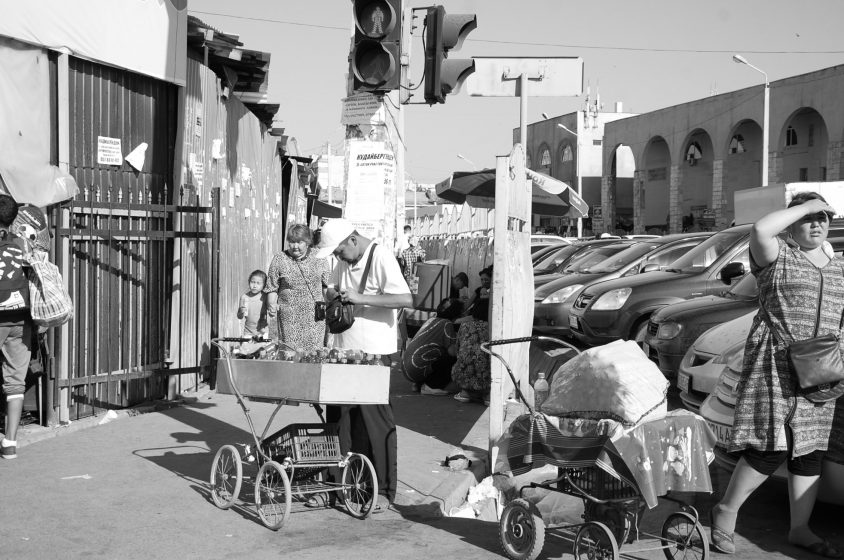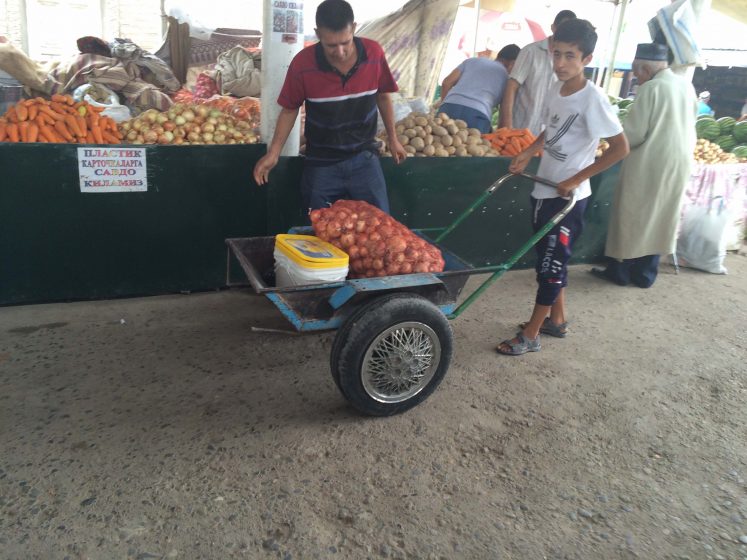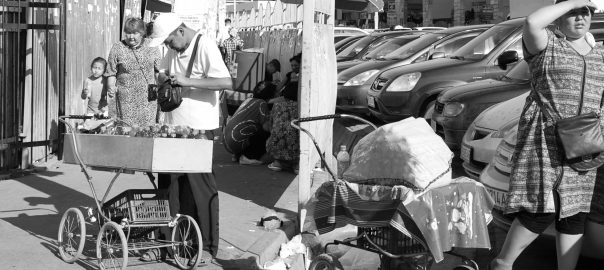Street vendors. Market peddlers. Musicians walking through subway cars. Parking spot guards and car watchers. Van drivers with handmade signs competing for passengers. Hawkers who sell stuff out of the trunks of their cars, out of baby carriages, and from bicycle carts. Hagglers looking to pocket some cash along the road, at a red light, or in busy intersections.
Should cities view people who claim public spaces through informal market activities as insecure persons—or as entrepreneurs?
Informal economic market activity comes in many varieties, and this type of unlicensed trade occurs in most cities worldwide. Maybe it’s hidden out of view in seedy back alleys or behind the markets where bootleggers with sketchy reputations secretly offer their wares. In other places, it’s out in the open, an accepted and normal part of the daily sell-and-buy routine for many products such as fruits, vegetables, household items, and clothing. In other corners of the world, informal markets come off as a sport, with petty traders doing a song and dance to gain attention and prospective buyers circling tables elbowing and jockeying for the best price.
However they are viewed, informal markets bring with them inherent challenges that many cities struggle to deal with.
A few months back, when I was in Bishkek, Kyrgyzstan, I had a long conversation about what cities can do about these activities with Lela Rekhviashvili, a post-doctoral researcher at Leibniz Institute for Regional Geography. Her area of study is in the informal economic practices of marginalized groups in urban settings; she has researched these informal practices in Georgia and was in Bishkek examining the marshrutka system, a complex public transportation web of mini-van operators that locals throughout post-Soviet countries depend on.

The urban dilemma
To understand the backdrop, cities have to look at who is involved.
Typically, shadow markets and illegal vending opportunities are the only source of income to a city’s poorest group of people. These are the people living on the fringe of society, scraping by and living in survival mode. They represent the part of society that falls between the cracks or those whom cities don’t know how to adequately help. In today’s political climate, many of these people have the faces of “undesirable” migrants who have washed up somewhere; they are the ones selling brand-knock-off sunglasses, purses, or watches on dingy sheets that can be quickly rolled up when the police come, or small pocket items such as cigarette lighters or packs of tissues out of plastic bags that can be easily stowed away.
“These are the ‘have-nots,’ people with low or no marketable skills who take on occupations with very little economic investment need,” said Rekhviashvili, who recently defended her doctoral dissertation, Counterbalancing marketization informally: Institutional reforms and informal practices in Georgia (2003-2012), at the Doctoral School of Political Science, Public Policy and International Relations, Central European University.
“When we talk about these small-scale informal practices, we have to think of it as the practices of ‘have-nots’ who do not have access to owning things, and they do not have the capital to invest in something.”
Although they may be among a city’s most vulnerable citizens, local officials and police who enforce city rules have a hard time managing these people’s needs. This is indicative of a double-sided dilemma cities face: How do you manage these activities—which are needed as income sources—without marginalizing people by defining which activities can appropriately take place in public spaces?
“The strategies these [marginalized] populations deploy rely on non-commodified resources, such as public space,” Rekhviashvili said. “So somebody comes and starts using public spaces and commercializes it, to a degree, but their access to this space is not commercialized. They don’t pay market value to anyone for standing there. The only thing that saves their access to this spot is that essentially another informal activity is taking place another 100 meters down. Access is ensured, in some ways, by the level of social approval… Access to the most important resources they have—the land and location—is not market-based, but based on social approval and also based on their claim to public resources being common resources that they can draw on.”
The questions of how public spaces should be used, and whether informal economic activities should take place in them, have many city officials’ heads spinning worldwide.
On an overarching level, the answers lie in how urban officials delineate public and private spaces and how they balance marketization of these places or commodify urban spaces. This process of marketization—which is a necessary part of capitalism, and by extension economic growth—plays a significant role in how informal practices take seed and expand or remain dormant activities.
But the actual management approaches are as varied as the economic practices they are meant to control.

Some city governments feel that these non-taxable activities hurt licensed commercial vendors who pay sales and property taxes and deserve more city support, prime selling space, and customer loyalty. In an effort to reduce what they call unfair competition, many cities (including European cities I have lived in and visited) take a harder stand on this; they not only make it illegal to sell goods informally on the street, but also impose hefty fines and/or prison sentences to those caught engaging in these practices.
Other places have developed more creative ways to integrate this marginalized population into mainstream society and have changed the way its constituents are viewed by the general citizenry.
And, at the extremes, cities without adequate resources have let informal economies run rampant without any control mechanisms in place, while others have gone as far as criminalizing homelessness, for example—which creates a vicious cycle of repeat offenders who can never rise above their lot in life, according to Rekhviashvili.
Creating balance
It’s hard to pin down one approach as a good one in all circumstances. In many situations, it boils down to a few key introspective questions.
“How do we see people who claim public spaces? Do we see them as entrepreneurs, or do we see them as insecure persons who have no other income or ways of generating income to secure their livelihoods?” Rekhviashvili asked. “These are two different kinds of judgments. An entrepreneur is seen as someone who turns profit into investment, expansion, and growth. But many of the people who engage in these activities are turning profit into survival.”
In a place like Tbilisi, Georgia, for instance, a street vendor or parking spot watcher can expand 50 meters more, but they cannot have a kilometer more, she noted. “They can’t go beyond that, again, because their access to the space is not private. They don’t own it. They only have it because somebody else approves of it….the immediate social context approves of it.”
If this is the case, and it’s likely that these practices won’t ever really vanish, how should cities monitor, control, or capitalize on them? Are there examples of cities handling such activities well?
“One way is the Bishkek way,” Rekhviashvili responded. “It’s fascinating to me. It really reminds me of the Georgia of the 1990s, where this ‘do it yourself strategy’ was allowed by the government. It’s the same here now. Everybody does a bit of informal things. Public spaces are not restricted. You can see a lot of vendors at the place of their convenience. Some trade with more things, some only sell a few things and you can see clearly that they don’t have anything else. They only sell strawberries, for example.”

The marshrutka mini-bus system is another example. The only thing the state regulates about them is the price of transit, she added. “Almost everything else about this is unregulated. The state does not intervene.”
Part of this may stem from state or city’s lack of resources to do more, resulting in their turning a blind eye to the web of informal practices tied to the marshrutka mini-buses, including drivers, dispatchers, and work standards.
For cities that may see such a hands-off strategy as giving away too much control, Rekhviashvili recommended regulations…but not regulations that criminalize the behavior, which often prove counterproductive in the longer term.
“Rules that criminalize these small-scale activities punishes people who are poor,” she said. “This, again, comes down to how do we want to see these people. The question of whether they are entrepreneurs, marginalized or criminals becomes an important discussion point.”
How does your city manage informal economic practices? How has public policy been shaped to integrate this activity into more formalized trading? What rules have or haven’t worked in delineating public spaces for this kind of use? How are informal vendors viewed in your city?
Jenn Baljko
See more about the trip here.







Leave a Reply